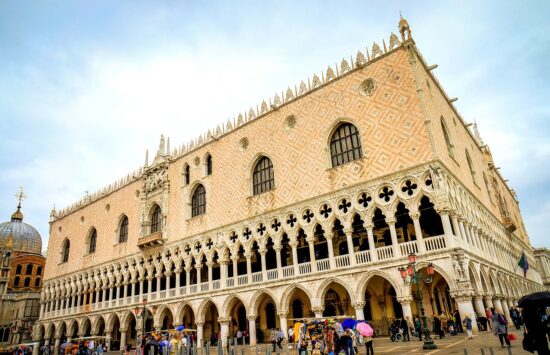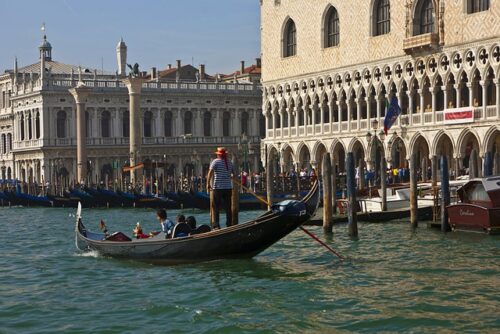Doge’s Palace
The Doge’s Palace can be described as the brain of the Serenissima Republica. It was right after his successful coordination of the defense of Venice against the Frankish army and his triumphant election as a doge in 810, that Agnello Participazio ordered the relocation of the administrative center of Venice from the island of Malamocco to the Rialto, where the new dogal palace, in essence, a large fort that would house the Doge’s apartments, courtrooms, prisons, various public offices, even stables would be built. The 10th-century castle was protected by a canal that served as a moat and massive corner towers, while its main gateway was where the Porta Della Carta stands today.
Nothing remains of that construction which was destroyed by a fire at the end of the 10th century set by the Venetians that were enraged by the machinations of their Doge Pietro IV Candiano to establish a hereditary monarchy. Another similar fort was constructed under the orders of the leader of the insurrection Pietro I Orseolo, who became doge and began its reconstruction immediately.


In 1172 Sebastiano Ziani, a doge that only ruled for six years would make his term one that would always be remembered by rescheduling the entire layout of Saint Mark’s square, relocating the shipyard that was too close to the palace, and creating two new wings, one facing the Piazzetta used to house the courts and the other, towards the lagoon for all the government institutions.
The Veneto-Byzantine architectural style (seen today in Fondaco dei Turchi for example) that prevailed in all of the palace’s structures would dominate until 1340 when the architect Filippo Calendario would take on the task of its enlargement and revamp in Gothic style. His work was only half done when he was hanged from the balconies of his construction after being found guilty of treason in 1355. The two distinct styles of the lower and the upper section of the facade overlooking the lagoon, are believed to be the result of that disruption.
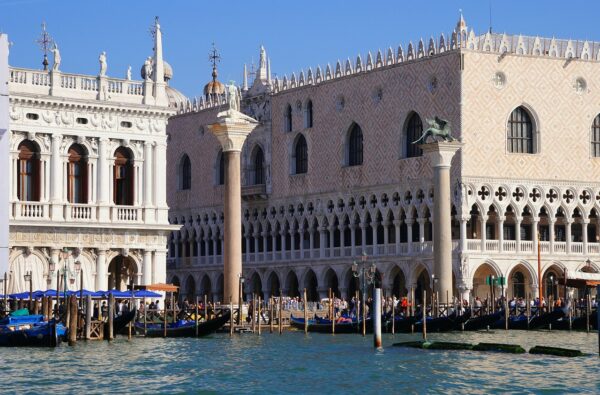
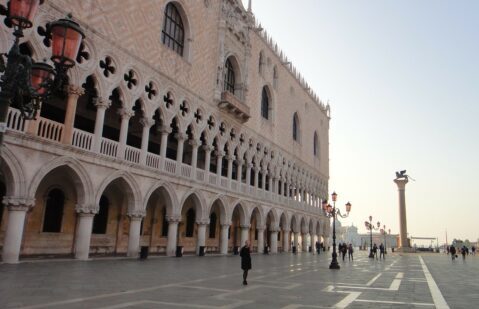
About 100 years after Calendario‘s first works, the wing on the side of the Piazzetta was also completed with its last component being that of the impressive Porta Della Carta, this fine mixture of Gothic and Proto-Renaissance architecture that forms the main entrance to the courtyard and was referred to as ‘Golden Doorway’ due to its extensive gilding when it was completed in 1442. After it was stripped from its gold the door was renamed based on the Venetian government’s practice of posting proclamations on the doorway.
Above the Porta Della Carta, a relief shows Doge Francesco Foscari doge of Venice from 1423 to 1457, when most of the work on the western side was undertaken, kneeling before the Lion of St Mark while the statues of Virtues (Prudence, Charity, Temperance, and Fortitude) stand on the side pillars.
Towards the end of the 15th century and during most of the 16th century various architects would introduce the Renaissance architectural style mostly in the features of the inner courtyard that lies behind the Porta Della Carta.
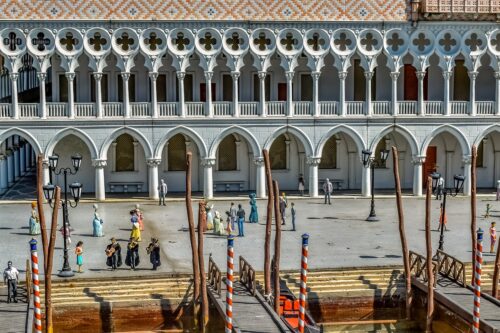
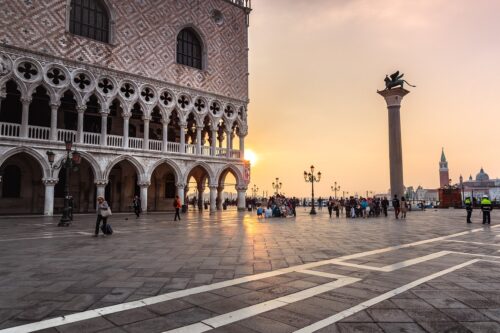
Exiting the vaulted corridor known as the Porticato Foscari to the triumphal arch Arco Foscari, decorated with sculptures of Adam and Eve one is faced by the grand staircase known as Scala di Giganti. Here the classical elements dominate with the colossal statues of Mars and Neptune on each flank representing the city’s power in land and sea.
The Scala served as the grand entrance to the palace where important ceremonies such as the coronation of the doge took place. On the right side of the Scala is the Senator’s Courtyard, where the members of the Senate met before their councils. Inside the Palace, the Golden staircase or Scala d’Oro the main internal staircase leads to the second floor and the Doge’s Apartments, now part of the itinerary in the museum.
Although not particularly large, the rooms stand out for their engraved wooden ceilings, their monumental marble chimneys with lavish, delicate carved decoration, and painting friezes and stuccoes. The furnishings were brought from the Doge’s own house and were removed by the end of each term to make way for the new Doge’s property. The whole section of these 9 rooms was destroyed by a fire in 1483 and then rebuilt in Renaissance style.
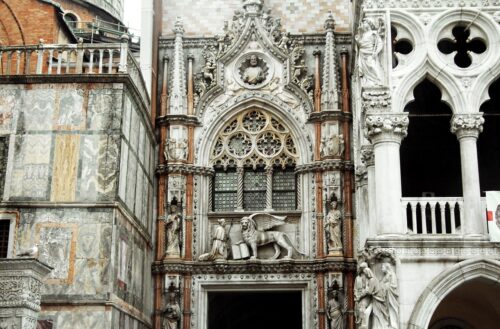
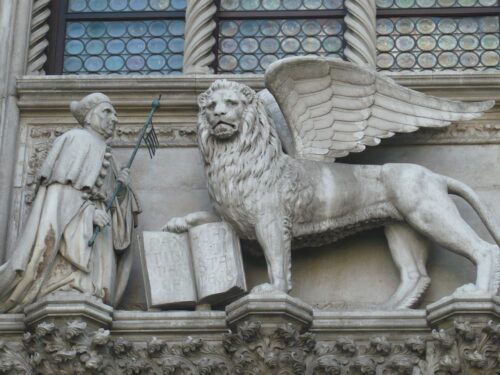
The first room, the Sala degli Scarlatti is probably the finest of all. It is named after the scarlet robes of the officers who attended the corpse of the Doge that was always laid in state in the adjacent Sala dello Scudo. The choice of color instead of the funeral black signified that the death of a doge did not diminish the government.
The Sala dello Scudo or the Shield Room, the largest of the apartments that follow is decorated with large geographical maps (the original from the 16th century, re-worked in 1762) showing the extent of the Republic’s domains and the distant lands explored by Venetian merchants. The two globes in the center are a contrast, with one depicting the surface of the Earth and the other being an imaginary depiction of the heavens. It was the room where the Doge received guests.
The Grimmani Sala that follows was the beginning of the doge’s actual private rooms. Today it is decorated with four large paintings of the Lion of Saint Mark. All the following rooms are adorned with paintings, engraved wooden ceilings, ornate stucco works, elegant decorative friezes, and vast fireplaces added over time by artists like Titian, Carpaccio, and Tintoretto.
The last room, the Sala dei Scudieri (The Equerries Room) was originally the room through which the visitors entered Doge’s apartments. It leads to the Scala d’ Oro again that takes you up to the first of the “Institutional Rooms”, the “Atrio Quadrato” the “Square Atrium”, the antechamber with the magnificent ceiling painted by Tintoretto in the 16th century.
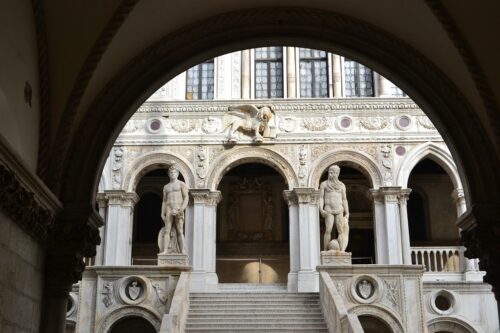
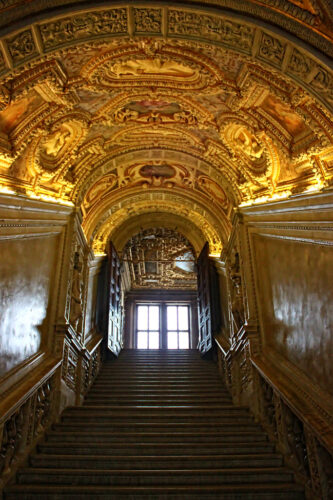
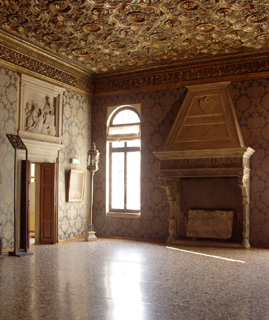
The small anteroom leads to one of the grandest antechambers of the Palace, the Sala Delle Quattro Porte, the “Four Doors Room”. This was originally the hall where the true governing body of the Republic was. The Collegio was comprised of the Doge and 22 high-ranking councilors. It was equivalent to today’s ministers and met daily. Its main job was to filter all the information that reached the larger governing body of the Senate or to receive hearings from foreign ambassadors.
After its destruction by two large fires in the 1570s the hall became the room where ambassadors waited until they addressed the Collegio. It is ornately framed in precious eastern marble, surmounted by allegorical sculptures that refer to the virtues which should inspire those who possess power. The magnificent stucco decoration painted by Tintoretto’s coffered ceiling and the painting by Titian on the wall make this a chamber you would gladly spend an hour waiting for.
Next in line is the Sala dell’Anticollegio, another waiting room for the foreign delegations that would have probably entered a state of trance up to that point. Venetians weren’t considered masters of diplomacy for no reason. The formal antechamber brims with masterpieces by Tintoretto, Veronese, and Jacopo Bassano.
At last, the Sala del Collegio, the main audience hall where the emissaries to Venice were ultimately admitted. This was the heart of Venice and is of course decorated accordingly. Veronese is the celebrated artist of the chamber, with his works almost exclusively adorning the walls and the ceiling.
The exception is Tintoretto whose paintings depict various Doges at times of contact with the divine. The Sala del Senato that follows is almost identical in the decoration chamber where the second most influential organ of the Venetian Republic determined policies that had to do with foreign affairs. It was here that Venetian ambassadors in other cities gave their reports but also on matters of crucial financial interest, always under the chairmanship of the doge.
Its members, from 120 initially to 300 towards the end of the Republic, were the city’s elite, the voices of the most established families of Venice. Prevailing here is the brush of Tintoretto and his pupils fringed with magnificent gilded stucco from the 16th century.
The Sala del Consiglio dei Dieci the Chamber of the Council of Ten, was established to protect the Republic from conspiracies of foreign or domestic enemies, even the doge himself if he ever tried to overthrow its democratic institutions. Its members were considered incorruptible and measures such as their obligatory confinement in the dogal palace during their one-year term worked as a safety net. The same motif of decoration with gilded stucco works and paintings by Veronese is followed here.

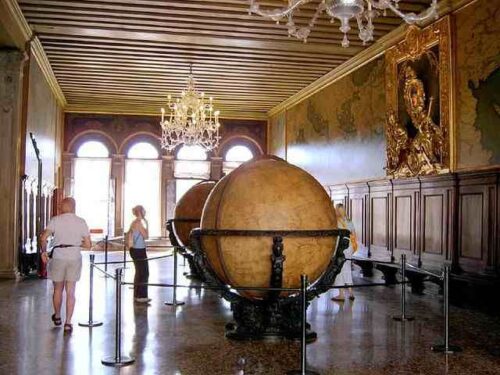

The Sala della Bussola, the Compass Room, the antechamber for those summoned by the Council of Ten, a room dedicated to the administration of justice and the Republic’s good governance, are the two most appreciated values of this council.
This room is linked by a corner door with the State Inquisitors’ Room, which in its turn led to the Torture Room and finally the prisons, a nightmare route for any prominent Venetian that can be accessed as part of the Secret Itineraries Tour today, a tour through the naked dark rooms where hard decisions and acts that had nothing to do with gilded glamour were taken. (More: http://palazzoducale.visitmuve.it/en/the-museum/layout-and-collections/secret-itineraries/)
Next stop the thrill of every kid, no matter the age. The Armory consisted of more than 2000 pieces of perfectly preserved swords, shields, helmets, guns, crossbows, spears..well everything that was used by the soldiers responsible for the defense of the palace through the years. These exquisite samples of 15th to 18th-century weaponry are some of the instruments that made Venice an empire.
Back to the second floor through the Scala Dei Censori and after passing the Liago del Maggior Consiglio, the Sala of the civil court, and the Sala del Guariento, you finally reach the enormous Chamber of the Great Council or Sala del Maggior Consiglio.
Nearly covering the entire length of the facade overlooking the lagoon. the 53 meters long, 25 meters wide, and 15 meters high chamber, one of the largest in Europe was the house of the assembly of all the patricians of the city that were over 25 years old. This was the house of the Republic.
More than 2000 guardians of the democratic institutions of Venice convened in this open field-like chamber, in a type of ancient Athens “dimos”, that formed the basis of all other authorities and conveyed the voice of the populace to the government.
It was initially decorated with paintings made by the most renowned painters of the 14th, 15th & 16th centuries like Pisanello, Titian, Bellini, Carpaccio, and Veronese that were destroyed by the fires of the 1570s.

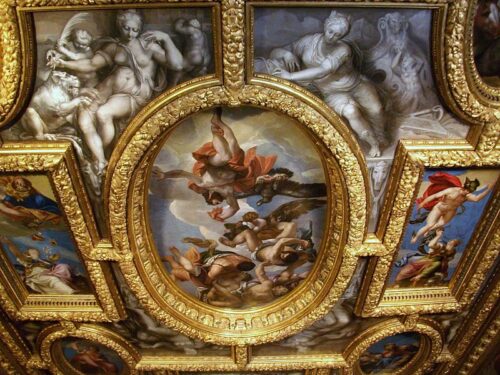

It was repainted by the favorite artists of the palace at the time, Veronese and Tintoretto. Tintoretto’s “Il Paradiso” on the wall behind the thrones was considered for many years the world’s largest painting on canvas. Jacopo and Domenico Tintoretto were the ones that re-sketched the portraits of the first 76 doges that appear at the frieze below the ceiling.
Note the black veil painted on the place where the portrait of Marin Faliero should be. He was tried for an attempted coup and beheaded on the crown of the Scala Dei Giganti.
The tour approaches its end with the Chamber dello Scrutinio, initially built to house the manuscripts offered by the Byzantine scholar Vessarion.
After the construction of Sansovino’s Library, it served as the hall where the electoral counting of the votes of the Great Council took place.
The Bridge of Sighs or Ponte dei Sospiri, the bridge built at the beginning of the 17th century to connect the palace with the new prisons on the other side of the canal was named by the Romantics in the 18th century, who imagined the prisoners taking their last look of the lagoon through the small windows of the enclosed on all sides bridge, will take you to the new prisons where only petty criminals were kept. You can still see some of their carvings on the walls.
Be sure to wear good walking shoes before you enter the palace and reach the entrance early in the morning or around noon when groups go to lunch if you want to avoid long lines. You will spend an intense 3 to 5 hours that will probably overload your brain receptors and make a general pause afterward more than necessary. Still, you haven’t seen Venice if you miss out on its dogal palace. Enjoy!
